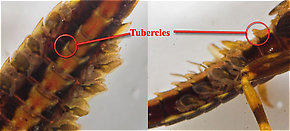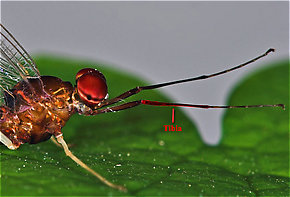Blog & Latest Updates
Fly Fishing Articles
Insects by Common Name


> > Miscellaneous
Closeup insects from Miscellaneous
Male Ephemerella invaria (Sulphur Dun) Mayfly Dun View 3 Pictures
View 3 Pictures
 View 3 Pictures
View 3 PicturesCollected May 29, 2004 from unknown in Wisconsin
Added to Troutnut.com by Troutnut on January 25, 2006
Added to Troutnut.com by Troutnut on January 25, 2006
Ephemerella (Hendricksons, Sulphurs, PMDs) Mayfly Nymph View 3 PicturesI confirmed with the microscope that this specimen has very small tubercles (
View 3 PicturesI confirmed with the microscope that this specimen has very small tubercles ( Tubercle: Various peculiar little bumps or projections on an insect. Their character is important for the identification of many kinds of insects, such as the nymphs of Ephemerellidae mayflies.), strongly double-banded tibiae (
Tubercle: Various peculiar little bumps or projections on an insect. Their character is important for the identification of many kinds of insects, such as the nymphs of Ephemerellidae mayflies.), strongly double-banded tibiae ( Tibia: A middle segments in the leg of an insect, located between the femur and the tarsus.), and a fan tail.
Tibia: A middle segments in the leg of an insect, located between the femur and the tarsus.), and a fan tail.
 View 3 PicturesI confirmed with the microscope that this specimen has very small tubercles (
View 3 PicturesI confirmed with the microscope that this specimen has very small tubercles (
A few (not all) of the abdominal tubercles on this Ephemerella needhami nymph are circled. They are especially large in this species.

The tibia of this Isonychia bicolor mayfly spinner is highlighted in red.
Collected March 10, 2004 from unknown in Wisconsin
Added to Troutnut.com by Troutnut on January 19, 2006
Added to Troutnut.com by Troutnut on January 19, 2006
Siphlonurus quebecensis (Gray Drake) Mayfly Nymph View 3 Pictures
View 3 Pictures
 View 3 Pictures
View 3 PicturesCollected May 18, 2004 from unknown in Wisconsin
Added to Troutnut.com by Troutnut on January 25, 2006
Added to Troutnut.com by Troutnut on January 25, 2006
Ephemerella (Hendricksons, Sulphurs, PMDs) Mayfly Nymph View 2 PicturesHere's a puzzling nymph. It seemed to have double-banded tibiae (
View 2 PicturesHere's a puzzling nymph. It seemed to have double-banded tibiae ( Tibia: A middle segments in the leg of an insect, located between the femur and the tarsus.), although the second band wasn't very pronounced. It has quite prominent tubercles (
Tibia: A middle segments in the leg of an insect, located between the femur and the tarsus.), although the second band wasn't very pronounced. It has quite prominent tubercles ( Tubercle: Various peculiar little bumps or projections on an insect. Their character is important for the identification of many kinds of insects, such as the nymphs of Ephemerellidae mayflies.) that definitely aren't black.
Tubercle: Various peculiar little bumps or projections on an insect. Their character is important for the identification of many kinds of insects, such as the nymphs of Ephemerellidae mayflies.) that definitely aren't black.
 View 2 PicturesHere's a puzzling nymph. It seemed to have double-banded tibiae (
View 2 PicturesHere's a puzzling nymph. It seemed to have double-banded tibiae (
The tibia of this Isonychia bicolor mayfly spinner is highlighted in red.

A few (not all) of the abdominal tubercles on this Ephemerella needhami nymph are circled. They are especially large in this species.
Collected March 10, 2004 from unknown in Wisconsin
Added to Troutnut.com by Troutnut on January 19, 2006
Added to Troutnut.com by Troutnut on January 19, 2006
Ephemerella invaria (Sulphur Dun) Mayfly Nymph View 3 Pictures
View 3 Pictures
 View 3 Pictures
View 3 PicturesCollected March 10, 2004 from unknown in Wisconsin
Added to Troutnut.com by Troutnut on January 19, 2006
Added to Troutnut.com by Troutnut on January 19, 2006
Male Ephemerella invaria (Sulphur Dun) Mayfly Dun View 3 Pictures
View 3 Pictures
 View 3 Pictures
View 3 PicturesCollected May 22, 2004 from unknown in Wisconsin
Added to Troutnut.com by Troutnut on January 25, 2006
Added to Troutnut.com by Troutnut on January 25, 2006
Male Baetidae (Blue-Winged Olives) Mayfly Dun View 4 PicturesThis ia a very tiny (hook size 22-24) dun. The pictures are terrible, but it's very fragile and it's one of the first adult mayflies I ever photographed.
View 4 PicturesThis ia a very tiny (hook size 22-24) dun. The pictures are terrible, but it's very fragile and it's one of the first adult mayflies I ever photographed.
 View 4 PicturesThis ia a very tiny (hook size 22-24) dun. The pictures are terrible, but it's very fragile and it's one of the first adult mayflies I ever photographed.
View 4 PicturesThis ia a very tiny (hook size 22-24) dun. The pictures are terrible, but it's very fragile and it's one of the first adult mayflies I ever photographed.Collected April 30, 2004 from unknown in Wisconsin
Added to Troutnut.com by Troutnut on January 25, 2006
Added to Troutnut.com by Troutnut on January 25, 2006
Female Baetidae (Blue-Winged Olives) Mayfly Dun View 3 Pictures
View 3 Pictures
 View 3 Pictures
View 3 PicturesCollected May 22, 2004 from unknown in Wisconsin
Added to Troutnut.com by Troutnut on January 25, 2006
Added to Troutnut.com by Troutnut on January 25, 2006
Ephemera simulans (Brown Drake) Mayfly Nymph View 2 PicturesHere's an unusually small early instar (Instar: Many invertebrates molt through dozens of progressively larger and better-developed stages as they grow. Each of these stages is known as an instar. Hard-bodied nymphs typically molt through more instars than soft-bodied larvae.) nymph.
View 2 PicturesHere's an unusually small early instar (Instar: Many invertebrates molt through dozens of progressively larger and better-developed stages as they grow. Each of these stages is known as an instar. Hard-bodied nymphs typically molt through more instars than soft-bodied larvae.) nymph.
 View 2 PicturesHere's an unusually small early instar (Instar: Many invertebrates molt through dozens of progressively larger and better-developed stages as they grow. Each of these stages is known as an instar. Hard-bodied nymphs typically molt through more instars than soft-bodied larvae.) nymph.
View 2 PicturesHere's an unusually small early instar (Instar: Many invertebrates molt through dozens of progressively larger and better-developed stages as they grow. Each of these stages is known as an instar. Hard-bodied nymphs typically molt through more instars than soft-bodied larvae.) nymph.Collected March 1, 2004 from unknown in Wisconsin
Added to Troutnut.com by Troutnut on January 25, 2006
Added to Troutnut.com by Troutnut on January 25, 2006
Ephemerella invaria (Sulphur Dun) Mayfly Nymph View 2 Pictures
View 2 Pictures
 View 2 Pictures
View 2 PicturesCollected March 10, 2004 from unknown in Wisconsin
Added to Troutnut.com by Troutnut on January 19, 2006
Added to Troutnut.com by Troutnut on January 19, 2006
Start a Discussion of Miscellaneous:
Top 10 Fly Hatches
Top Gift Shop Designs
Eat mayflies.
Top Insect Specimens
Miscellaneous Sites
Troutnut.com is copyright © 2004-2024 Jason
Neuswanger (email Jason). See my FAQ for information about use of my images.
 privacy policy
privacy policy
